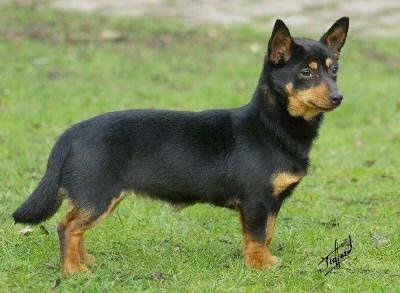
Nikki, a black/tan Lancashire Heeler age 7 months. Photo Courtesy of Hotpot Lancashire Heelers.
lang-kuh-sheer hee-ler
The Lancashire Heeler is set low to the ground; legs are short in relation to the rest of the body. It has wide-set larger ears. The ears should be erect; drop ears are undesired by breeders. The head is always in proportion with the body. The bright eyes are set wide apart. The legs are short and sturdy and the paws turn out slightly. The hindquarters are very well muscled. The chest is long and deep and the abdomen is firm. The back is strong. The tail is set high and carried forward over the back. The coat is seasonably long or short. In the wintertime the coat is plush with a visible mane and in the summer it has a sleek, shiny coat.
The Lancashire Heeler is very alert and friendly with those he knows but may be wary of strangers. An excellent ratter with rabbit catching potential, it has superior strength and broad instinctive abilities. This breed makes a pleasant companion, and does best with older, considerate children. The Lancashire may nip at people’s heels as it has a strong instinct to herd and must be taught not to do it to people. This breed may be difficult to obedience train, but it is trainable. While it has great herding instincts and will make a wonderful herder of cattle, goats and horses, it is rarely used as such. Make sure you are this dog's firm, confident, consistent pack leader to avoid Small Dog Syndrome, human induced behavior problems. Always remember, dogs are canines, not humans. Be sure to meet their natural instincts as animals.
Height: 10 - 12 inches (25 - 31 cm)
Weight: 6 - 13 pounds (3 - 6 kg)
--
This breed is a good dog for apartment living. It is very active indoors and will do okay without a yard as long as it is properly exercised. This breed will do okay in colder climates as long as it has proper shelter.
The Lancashire Heeler has a lot of energy and it must be kept busy. It needs to be taken on a daily, brisk, long walk. While out on the walk the dog must be made to heel beside or behind the person holding the lead, as in a dog's mind the leader leads the way, and that leader needs to be the human.
12-13 years
About 2 to 5 puppies
This breed is easy to groom. Comb and brush with a firm bristle brush, and bathe only when necessary. The coat is seasonably long or short. In the wintertime the coat is plush with a visible mane and in the summer it has a sleek, shiny coat.
When people no longer greatly relied on cattle dogs, the Lancashire Heeler declined in numbers greatly to the point of practical extinction. Today's Lancashire Heelers are a re-creation of the original Lancashire Heelers. The re-creation has lines of the Welsh Corgi and the Manchester Terrier. Today's Lancashire Heelers are almost identical to the Lancashire that existed a long time ago. Although the new Lancashires retain the excellent ability to herd, they are now rarely used for cattle herding.
Herding
Bessie, a toy Lancashire Heeler

Tammy, a liver/tan female, photo courtesy of Hotpot Lancashire Heelers